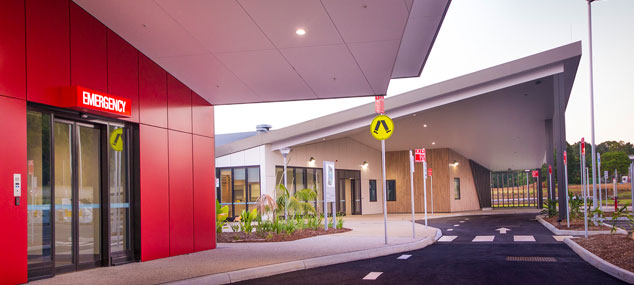
Northern NSW Local Health District (NNSWLHD) hospitals continued to reduce the overdue planned surgery wait list despite sustained high activity in emergency departments (EDs) throughout winter, according to the latest Bureau of Health Information Healthcare Quarterly report.
Northern NSW Local Health District’s Chief Executive, Tracey Maisey, said the results are a reflection of the continued hard work of staff across the District during the July to September quarter in 2023.
“There were 54,204 attendances to NNSWLHD EDs, an increase of 2.1 per cent, or 1,134, more attendances than for the same quarter in 2022. There were also increases in presentations across all triage categories,” Ms Maisey said.
“More than seven in 10 patients (75.3 per cent) started treatment on time and eight in 10 patients (80.1 per cent) were transferred from ambulance to ED staff within the 30-minute benchmark, which are both better results than the NSW state average.”
All patients are seen and triaged on arrival at the ED and, as always, the most seriously unwell patients are treated first. During busy times, those with less urgent conditions can experience longer wait times when there are large numbers of seriously unwell patients being prioritised for emergency care.
Across the District, there were 3,770 planned surgeries performed during the quarter.
The majority of all planned surgeries, including 95.5 per cent of urgent planned surgeries, were performed on time. The percentage of semi-urgent and non-urgent planned surgeries performed on time also improved by 4.9 and 12.6 percentage points respectively, compared with the same quarter in 2022.
Over the past year, NNSWLHD reduced the number of patients waiting longer than clinically recommended for planned surgery by 55.1 per cent, from 1,580 at the end of September 2022 to 709 at the end of September 2023.
Any patient who feels their condition may have deteriorated while waiting for their surgery is encouraged to contact their treating doctor who can review their condition and place them in a higher urgency category, if appropriate.
NNSWLHD continues to remind everyone to support us by saving emergency departments and ambulances for saving lives. If an illness or injury is not serious or life-threatening, we encourage people to call Healthdirect Australia on 1800 022 222, for 24-hour telephone health advice.
Individual hospital results
BALLINA DISTRICT HOSPITAL had 4,345 ED attendances during the quarter. The majority of patients (69.5 per cent) started their ED treatment on time. More than seven in 10 patients (75.8 per cent) left the ED within four hours. More than eight in 10 patients (83.4 per cent) were transferred from ambulance to ED staff within the 30-minute benchmark.
BYRON CENTRAL HOSPITAL had 5,262 ED attendances throughout the third quarter of 2023. The majority of patients (86.1 per cent) started their ED treatment on time and almost eight in 10 patients left the ED within four hours of arriving. More than nine in 10 patients (94.5 per cent) were transferred from ambulance to ED staff within the 30-minute benchmark.
CASINO & DISTRICT MEMORIAL HOSPITAL had 3,219 ED attendances in the quarter. The majority of patients (75 per cent) started treatment on time and more than eight in 10 patients (84.5 per cent) left the ED within four hours of arriving. More than nine in 10 patients (93.5 per cent) were transferred from ambulance to ED staff within the 30-minute benchmark.
GRAFTON BASE HOSPITAL had 6,732 ED attendances during this quarter. The majority of patients started treatment on time and more than seven in 10 patients (70.7 per cent) left the ED within four hours. More than eight in 10 patients (83 per cent) were transferred from ambulance to ED staff within the 30-minute benchmark.
LISMORE BASE HOSPITAL had 10,050 ED attendances during the quarter, which is a 5 per cent increase compared with the same time last year. The majority of patients (63.6 per cent) started their treatment on time. The majority of patients also left the ED within four hours of arriving (55.2 per cent), which is better than the average for hospitals of a similar size in NSW.
MACLEAN DISTRICT HOSPITAL had 3,790 ED attendances during the quarter. More than eight in 10 patients (82.8 per cent) started their treatment on time. Almost nine in 10 (88.7 per cent) of patients left the ED within four hours. Nine in 10 patients were transferred from ambulance to ED staff within the 30-minute benchmark.
MURWILLUMBAH DISTRICT HOSPITAL had 4,814 ED attendances during the quarter, an 8 per cent increase compared with the same time last year. The majority of patients (82.1 per cent) started their treatment on time, which is significantly better than the average for hospitals of a similar size in NSW. More than eight in 10 patients (84 per cent) left the ED within four hours of arriving. Almost all patients (95.8 per cent) were transferred from ambulance to ED staff within the 30-minute benchmark.
THE TWEED HOSPITAL had 13,799 ED attendances during the quarter. More than eight in 10 patients (80.3 per cent) started their treatment on time, which is significantly better than the average for hospitals of a similar size in NSW. Almost seven in 10 patients left the ED within four hours of arriving, and more than eight in 10 patients (82.4 per cent) were transferred from ambulance to ED staff within the 30-minute benchmark.